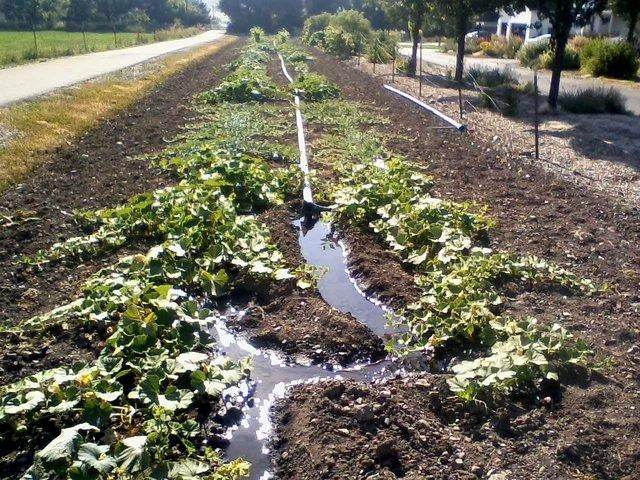Is there an error?
Let's take 1 acre. It is 208.7 feet on a side (if square). The fraction occupied by hedge is:
1 - (208.7-2*20)^2 / 208.7^2
which is the 34.7% number I produced.
How much is sheltered?
It is a 20 foot tall hedge, so we are assuming 140 feet is sheltered. We are talking about sheltering crop, so it is 140/(208.7-2*20), which is the 83% number I had.
The problem is that some of that sheltered area, is hedge.
Our sheltered area is 140*(208.7-40). The total area is 208.7^2. That ratio is 54.2%.
The idea behind sheltering, is that what is being sheltered, sees benefits. So a question I will ask, is there some benefit to the hedge, if it is sheltered by the hedge? I suspect the answer to that is species specific. Self-sheltering of nitrogen fixing hedge species might result in more fixing of nitrogen.
If we didn't have hedges, we might see depressed yields of something like 3% due to wind damage (ignoring wind effects like lodging), and then we have other effects like increased evaporation. So maybe we call it 6%?
208.7^2 * 0.94 = 40942 (and ignoring fractional square feet)
With our 20 foot hedge, we will guess that we have 100% on the sheltered area and 94% on what isn't sheltered (there should be a transition, not a sharp change).
0.542*(208.7-40)^2+0.94*(1-0.542)*(208.7-40)^2 = 27678
So our 1 acre field which has only 0.542 acres of plantable area, is producing a yield expected for 0.676 acres (with no windbreak). That is an overproduction ratio of 1.25. (Or maybe I made a calculation error again?)
Some fraction of the 34.7% of the land that is taken by the hedge, can be used for other crops. Crops like berries. And it is possible that for the 8 different "buffer" regions, you might have 4 different "best use" crops.
Yes, we are only producing 67.6% of the crop if we mono-cropped the entire 1 acre. But almost 45% of that land can be producing potentially 4 different crops for the farm. The hedge itself takes up some ground, so maybe you say that 30% of the land can be used for other crops.
What does our 20 foot tall, 20 foot wide hedge buy us?
* We now have a buffer of 20 feet from any of our neighbours, to stop things like diseases from getting to our crop.
* Wind born problems (pollen?)
* Our margin crops, are growing under a canopy. They are partially protected from things like hail and lodging.
* We could choose to just grow a ground cover crop, such as clover. It could be a nitrogen fixer or an accumulator. It could be providing nutrients to the 54.2% crop that is our main effort. Which means we might not need as much fertilizer (or we could see increased yields near the border).
An article from Australia (about living fences, has good descriptions on many of the effects of windbreaks -
http://www.rainforestinfo.org.au/good_wood/livng_fs.htm ).
I did GPS/GIS work for Alberta Agriculture. We had projects all over Alberta, including places which suffered thgrough the dustbowl era.
If we were to fertilize a field in strips, with spaces in between that are not fertilized and we were to monitor grain yield in the combine driving perpendicular to these strips, we would see changes in yield, but these changes would not be step changes (but the fertilizer application is (almost)). And the changes would be offset from where the grain was grown (best seen by varying the width of the non-fertilized areas).
How one has to unmangle this, is something called deconvolution. In fields and crops I was looking at (for a particular kind of combine), the "delay" between hitting a change in crop properties, and some change in yield on the combine was about 25 seconds.
Anyway, when a person (approximately) deconvolved the yield data (trying to assign the yield not to the location where the combine was when the grain passed the yield sensor, but rather to the location on the field where the grain came from), you could see the presence of former barbed wire fences across some of the fields. Even though barbed wire does not present a large barrier to wind, old fencelines had higher productivity due to trapping some of the soil blown off the land in the dust bowl era.
We don't use small fields for farming in North America, but they are useful for special purposes such as growing single species corn. But there are places in the world where the average farm is around 2 acres. If we choose to use the under canopy area of border hedges, we could produce 5 crops from a field instead of 1. Which leaves us much less susceptible to crop losses due to disease or weather (not all eggs in one basket).
Let's throw one out there. On the south side of a south hedge, we enclose the side from the canopy to ground level and inside (under the canopy) we have a vertical array of tomato plants. Little or no wind, controlled evaporation losses, no wind blown disease or pests, captive bees for pollinating, and so on. How many tomatoes can a greenhouse grow in (208.7)*(20/3)*15= 20,870 cubic feet?

 2
2









 1
1





 2
2





 1
1




 1
1












 1
1
















![Filename: atanWind.png
Description: Handwaving streamlines for windbreak [Thumbnail for atanWind.png]](/t/89168/a/62734/atanWind.png)
 1
1








 2
2


































 1
1








 1
1













